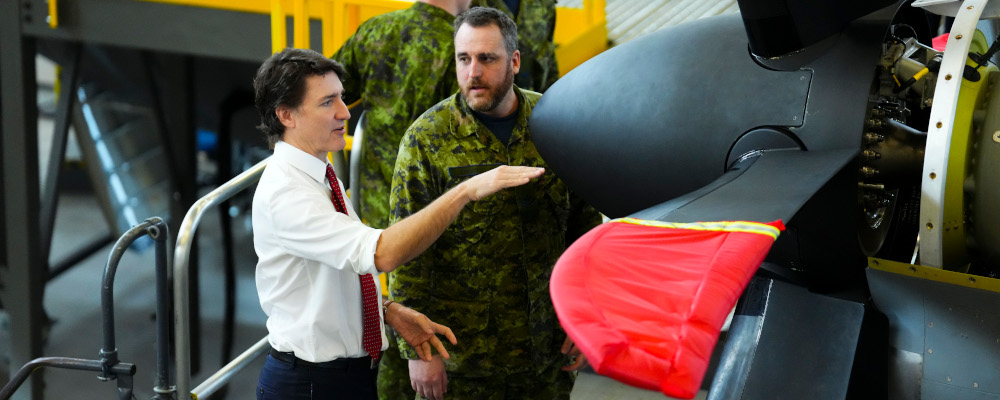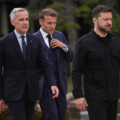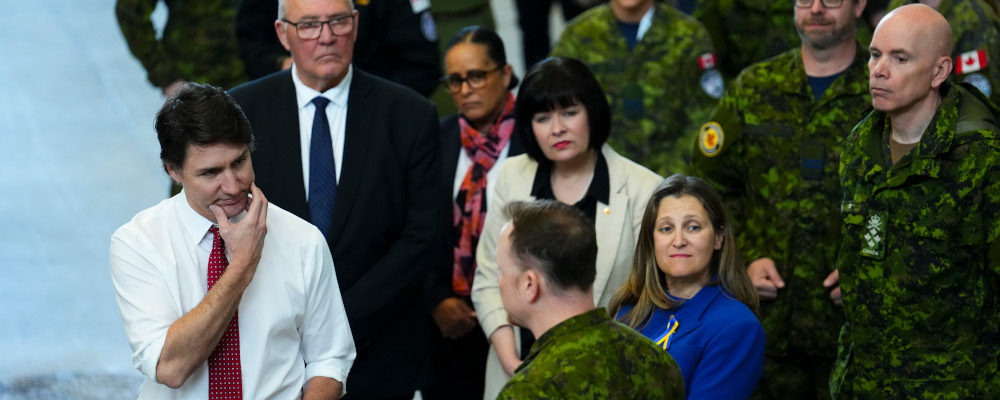This past Monday Sean Speer and Taylor Jackson published an excellent breakdown of Canadian defence spending as part of The Hub’s new DeepDives series. Its release is timely for a number of reasons. Importantly, it provides critical context for the recent federal budget and defence policy update that preceded it. However, its greater value became immediately apparent on Wednesday following Minister of National Defence Bill Blair’s comments at a Canadian Global Affairs Institute conference on NORAD modernization. The most explosive line was his statement that it was difficult to convince his cabinet colleagues to agree to hit NATO’s 2 percent threshold because “nobody knows what that means.”
I wish I could say this is surprising, but it is not. There is a broad ignorance concerning foreign and defence policy not only among his cabinet colleagues but also among the Canadian public.
There are many reasons why the government should aim to reach the 2 percent target (which we will not fully rehash here) including the political cost of failing to provide adequate security, the risks of failing to properly manage military capabilities to meet the threats Canada faces, and the reputational damage incurred with our allies by being so out of step with their interests.
Instead, it’s more interesting to understand why the contours of this debate align as they do.
For a variety of reasons, Canadians’ overall defence and foreign policy literacy is low. For one, only very small segments have ever served in the military. Perhaps more problematic is that Canada’s defence civil society is extremely weak compared to other countries: there are very few people whose job it is to cover, analyze, critique, or advance thinking on defence issues. Into this vacuum misinformation, sensationalist and poorly thought out takes fill in, further confusing the public on really essential issues concerning national security. That is unfortunate, as potentially a majority of Canadians have good instincts and a genuine interest in Canada having a strong international role commensurate with its size. But most simply have no conception of what that means and are easily led astray.
It is also fairly evident that there are ideological views about the military and international relations writ large that are simply ignorant of the reality. Our political leadership frankly are lightweights among our international peers. The last leader who was held in very high regard for their views on international relations was the recently departed Brian Mulroney. Stephen Harper and Paul Martin at times rose to that level, but it has been a relatively thin record over the past fifty years. More often than not, parochialism, ignorance, and domestic political concerns have guided Canada’s political leadership’s international instincts.
Part of the issue is ideological in nature. It is evident that members of the ruling Liberal Party subscribe to a very naive understanding of international relations and military affairs. Glaringly, they have consistently misunderstood and understated the lengths to which China, Russia, and other authoritarian governments seek to overturn the international order and the risks to Canada—up to and including direct interference in Canadian democracy itself.
Similar issues are evident among some members of the Conservative Party. During his final years in office, Harper, based on a broader policy of fiscal austerity, pursued deep budget cuts that severely affected the military’s readiness for the next decade. Similarly, the Conservative Party’s recent vote against the Ukraine free trade agreement because of its carbon tax provisions, despite trenchant support for the beleaguered state, illustrates how even minor ideological wins can override major foreign policy priorities.
The broad lack of understanding about defence and foreign policy issues feeds into the budget debate. I have long had one thought about the public’s view on defence spending: the actual dollar amounts do not matter that much. Instead, the political perception is all that matters.
More generally, Canadians have lost their reference points concerning government spending. During COVID the government spent hundreds of billions of dollars to keep the economy afloat and people safe. Certainly, much of it was necessary, but very large investments and spending programs (which were by no means exclusive to the COVID response) have undermined the public’s understanding of what these dollar amounts mean.
There is no better example of how the numbers do not matter than what occurred with the CF-18 replacement saga. In 2010 the Department of National Defence, based on a fairly in-depth analysis, sought to sole source 65 F-35s for $8.9 billion dollars CAD. It was clear that it was the lowest cost, most capable option that Canada could acquire.
The Liberal Party, during the 2011 and then 2015 elections, railed against the purchase, claiming it was an unaffordable and unnecessary “stealth” fighter that did not suit Canada’s interests. Once in office, their solution was to acquire a significantly more costly, less capable option: an “interim capability” of 18 Boeing Super Hornets. Instead of spending $9 billion for 65 F-35s, the governing Liberals now proposed spending $6.3 billion for 18 aircraft through a sole source contract.

Did the Canadian public revolt over this looming boondoggle? Not really. The only concerns were raised by experts who understood the disaster the government was planning to inflict on the country’s national security. There was absolutely no suggestion from the public that this was unacceptable. The Liberals were able to gesture vaguely at the fighter jets they did eventually purchase and the public was mollified that at least they were doing something—even if that “something” was the more expensive, less effective solution. No opposition party sought to subsequently weaponize this for their own purposes, and the issue failed to achieve liftoff. Which is fine for those parties’ domestic political concerns, but ultimately bad for the country in the long run.
Returning to our present 2 percent debate, this context of negligence from our leaders and ignorance from the masses explains why Blair’s cabinet colleagues refuse to commit to spending to that threshold. Again, it is not about the actual amounts. Rather it is the political perception of simply spending more, however incrementally and ineffectively, that is being prioritized. That’s likely why the DPU effectively commits Canada to reaching the 2 percent target while at the same time loudly proclaiming that it actually doesn’t. It allows the political leadership to have it both ways; to say to its core constituents that it is being fiscally responsible while claiming to allies that they actually will meet Canada’s obligations.
Allies are unlikely to be swayed. Most of Canada’s European and Asian partners have been able to raise their defence and reach or exceed the 2 percent threshold despite also having domestic priorities like health care, social security, and infrastructure. But they see the deteriorating condition of the international system and, determined to actually do something about it, have raised defence spending as a result. To them, Canada’s schtick is getting old.
Furthermore, I suspect Blair, like Anita Anand before him, understands what the budget choices mean. They are clear about the dire situation the military is in and almost certainly realize that if the objective is to even just maintain the extremely limited capability the military has now, 2 percent spending will not be close to sufficient. But again, it is simply domestic political concerns that are driving decision-making here.
Unfortunately, there are no easy answers to address this situation. Raising the education level of Canadians on these issues would certainly help, but that involves a level of policy coordination across different levels of government and civil society that is hard to imagine coming to fruition. Ideas about national service potentially might address this issue, but it would be extremely costly, further waste precious defence resources, and be politically untenable.
The problem with facing big problems is that it can be hard to know where to begin fixing them. But that doesn’t mean we shouldn’t try anything. If Blair is failing to find the traction he needs within his own government, then it may be up to the next to offer a clean start. The Conservatives should be eager to champion this cause, if only because it offers another stark area of differentiation between them and the Liberals that they can lean into. Yes, this would be another domestic audience play, but at least it’s one with the added advantage of beginning the country’s slow climb out of this mess. There are worse legacies Pierre Poilievre could leave than being the prime minister who arrested Canada’s decline into military and international irrelevance.
My advice? The 2 percent spending threshold is a helpful target, but ultimately irrelevant if the broader system itself is not fixed. At this point, far more important is what we spend on, and how, than necessarily how much. We need to get that right before the rest can follow.
Recommended for You

Liberals surpass 2025 foreign worker target six months into the year

Rudyard Griffiths and Sean Speer: Carney’s Kyiv statement was pure fantasy given the state of Canada’s military

Peter Menzies: Sorry, prime minister, but Canada’s news industry needs more than the CBC to thrive

Need to Know: Adulthood is increasingly on hold for young Canadians—and it’s not their fault





